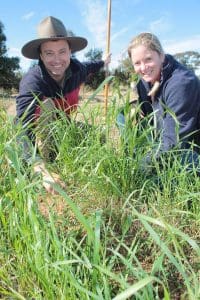
NSW DPI’s Matthew Newell and Susan Langfield evaluate perennial wheat grazing trials at the Cowra Agricultural Research and Advisory Station.
DUAL purpose perennial grain-grazing crops are a step closer with the addition of new American wheat varieties to a NSW research project.
NSW Department of Primary Industries researcher, Matthew Newell, has returned from The Land Institute (TLI), a non-profit research organisation in Kansas, with 18 new lines of wheat to bolster 20 existing lines currently under investigation at Cowra in central west NSW.
“DPI evaluation trials demonstrated perennial cereal crops could be produced in Australia with the potential to boost sustainability.
“Now with 18 new TLI-bred lines, 10 of which are registered Kernza® lines, we aim to expand our research and focus on developing robust perennial wheat suited to grazing and grain production under Australian conditions,” Mr Newell said.
Click here to get the latest Sheep Central story links sent to your email inbox.
Kernza® is an intermediate wheatgrass, a perennial relative of traditional annual wheat, which is commercially available in a staged release to select US restaurants and a brewing company producing Long Root Ale, a beer named after the plant’s root system.
Intermediate wheatgrass is a perennial cool-season forage grass that has been bred for large seed size and yield to become the first perennial grain crop in the US. Kernza production is regarded in the US as having potential to improve agricultural sustainability compared to annuals, because its extensive root systems reduce soil erosion and nutrient leaching, while simultaneously increasing farmer incomes due to decreased annual inputs and costs.
Mr Newell said the aim is to develop perennial cereals as dual purpose crops to better integrate livestock and cropping enterprises.
“Perennial wheat has high energy and digestibility levels for grazing stock, with the added bonus of producing high protein grain,” he said.
“These dual purpose crops could provide valuable winter forage for livestock, at a time when pasture growth is limited, and in the right conditions be harvested for grain.
“Farmers growing perennial wheat would have the opportunity to spell pastures while the wheat crop is grazed, increasing feed availability and generating pasture growth to increase carrying capacity and farm productivity.”
New dual purpose cropping systems based on perennial crops could help farmers adapt and better manage climate variability by putting extra flexibility into local farming systems.
In marginal cropping areas, particularly in drought years, perennial wheat may allow farmers to vary their inputs, reduce costs and deliver environmental benefits.
Perennial crops can take advantage of out-of-season rain, which helps increase water-use efficiency, reduce soil acidification and salinisation and has the potential to reduce erosion.
Source: NSW DPI.

HAVE YOUR SAY